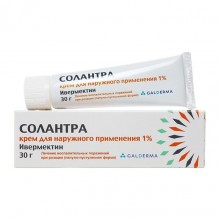Clinical Pharmacology
Antimicrobial and antiprotozoal agent. Ivermectin belongs to the avermectin group. which has an anti-inflammatory effect by suppressing the production of inflammatory cytokines induced by lipopolysaccharides. The anti-inflammatory properties of topical ivermectin have been observed in animal models of inflammatory skin processes. Ivermectin also causes death of parasites, mainly through selective binding and high affinity for glutamate-regulated chlorine channels found in nerve and muscle cells of invertebrates. The mechanism of action of Solantra in the treatment of inflammatory skin lesions in rosacea is not known, but it may be associated with both the anti-inflammatory effects of ivermectin and the ability of ivermectin to kill Demodex mites, which, in turn, are a factor causing skin inflammation. The absorption of ivermectin contained in Solantra was evaluated in a clinical study involving adult patients with severe papulopustular rosacea who used the maximum dose of the drug. In equilibrium (after 2 weeks of treatment), the highest mean (± standard deviation) plasma ivermectin concentrations were observed within 10 ± 8 hours after drug administration (Cmax 2.1 ± 1.0 ng / ml, range: 0.7 -4.0 ng / ml), and the highest mean (± standard deviation) AUC0-244 was 36 ± 16 ngh / ml, range: 14-75 ngh / ml). Systemic exposure to ivermectin reached a plateau by the end of the second week of treatment under steady state conditions. With longer treatment in the Phase 3 studies, the systemic exposure to ivermectin remained the same as after 2 weeks of treatment. Under conditions of equilibrium concentration, the levels of systemic exposure to ivermectin (AUC0-244: 36 ± 16 ng h / ml) were lower than after a single oral administration of 6 mg ivermectin in healthy volunteers (AUC0-244: 134 ± 66 ng h / ml). An in vitro study has shown that the binding of ivermectin to blood plasma proteins (mainly albumin) is more than 99%. No significant binding of ivermectin to erythrocytes was observed. In in vitro studies using human liver microsomes and recombinant CYP450 enzymes, it has been noted that ivermectin is metabolized primarily by CYP3A4 inhibitors. In vitro studies have shown that ivermectin does not inhibit CYP450 isoenzymes 1A2, 2A6, 2B6, 2C8, 2C9, 2C19, 2D6, ZA4, 4A11 or 2E1. Ivermectin does not induce the expression of CYP450 enzymes (1A2, 2B6, 2C9, or 3A4) in human hepatocyte culture. The 2 main metabolites of ivermectin (3 "-0-demethyl ivermectin and 4a-hydroxy ivermectin) were identified in a clinical pharmacokinetic study using the maximum permissible dose of the drug and studied during phase 2 clinical trials. Like the parent compound, the metabolites reached an equilibrium state by the end of the second week of treatment, with no signs of accumulation observed until 12 weeks. In addition, systemic exposures to metabolites (assessed using Cmax and AUC) obtained at steady state were much lower than those after oral ivermectin. The terminal elimination half-life was, on average, 6 days (approximately 145 hours, range: 92-238 hours) in patients who applied the drug to the skin once daily for 28 days during a clinical pharmacokinetics study using the maximum allowable dose of the drug. Excretion from the body depends on the degree of absorption after external application of Solantra cream. The pharmacokinetics of ivermectin have not been studied in patients with impaired liver and kidney function.


